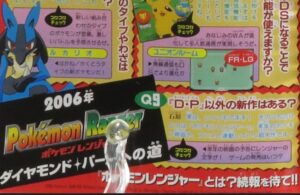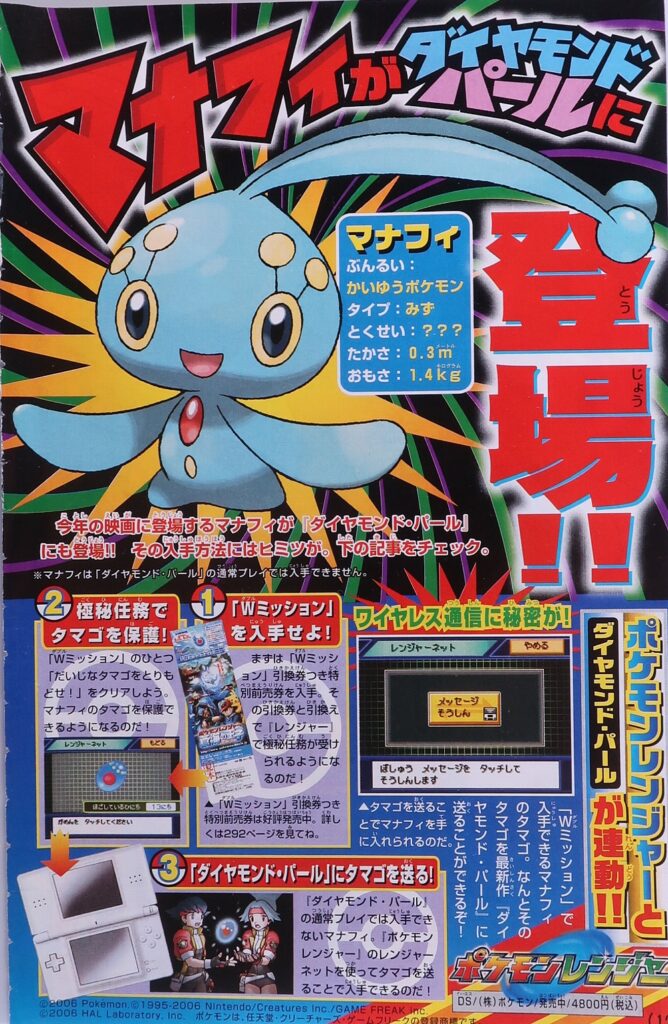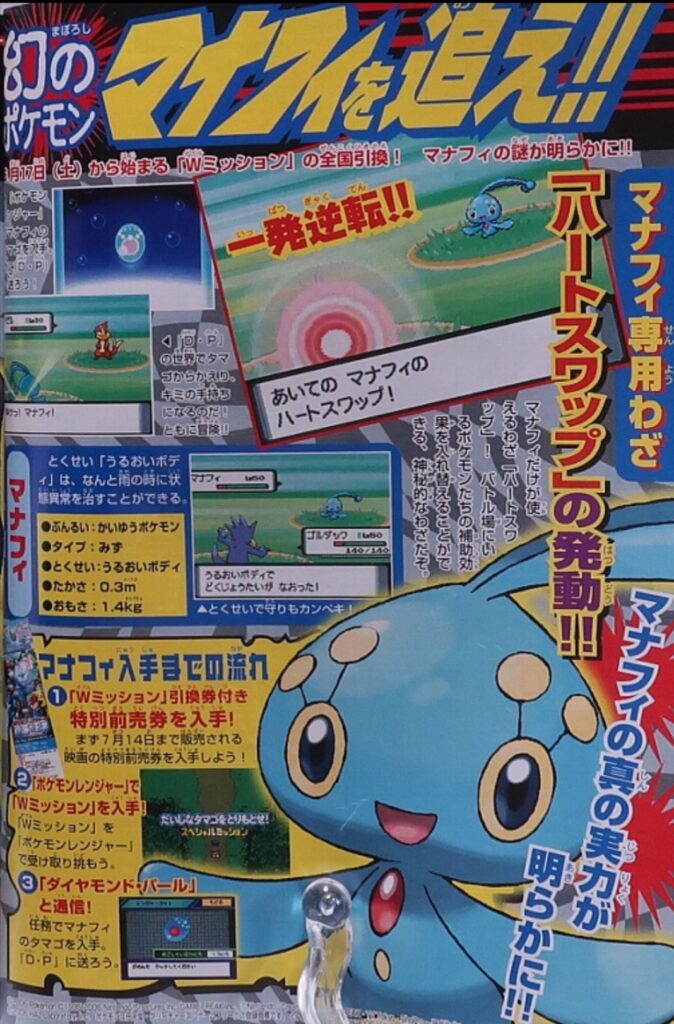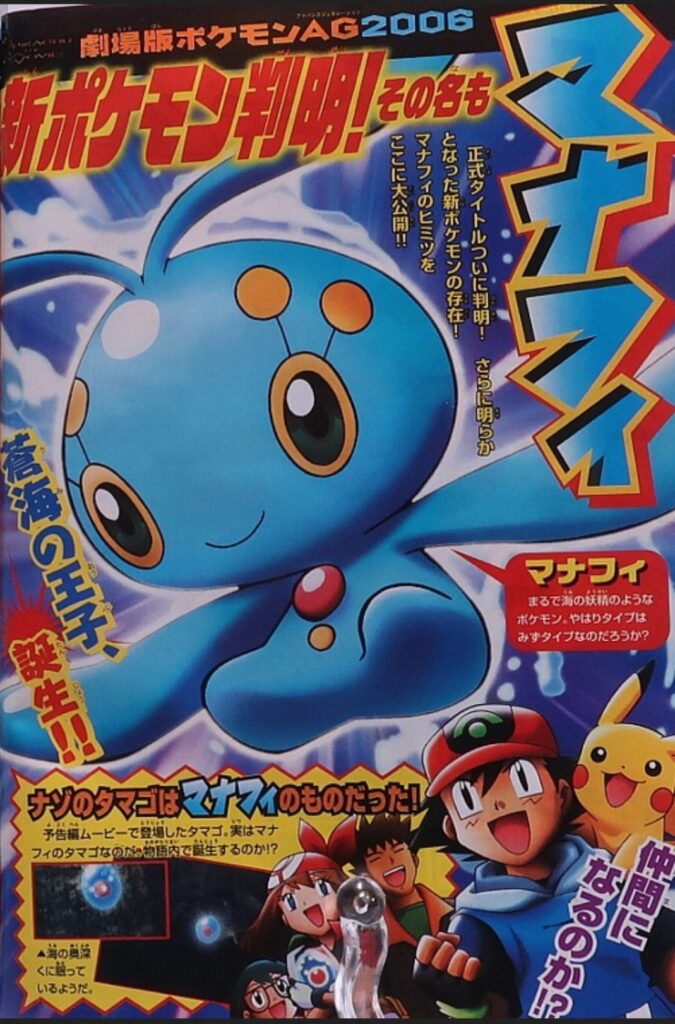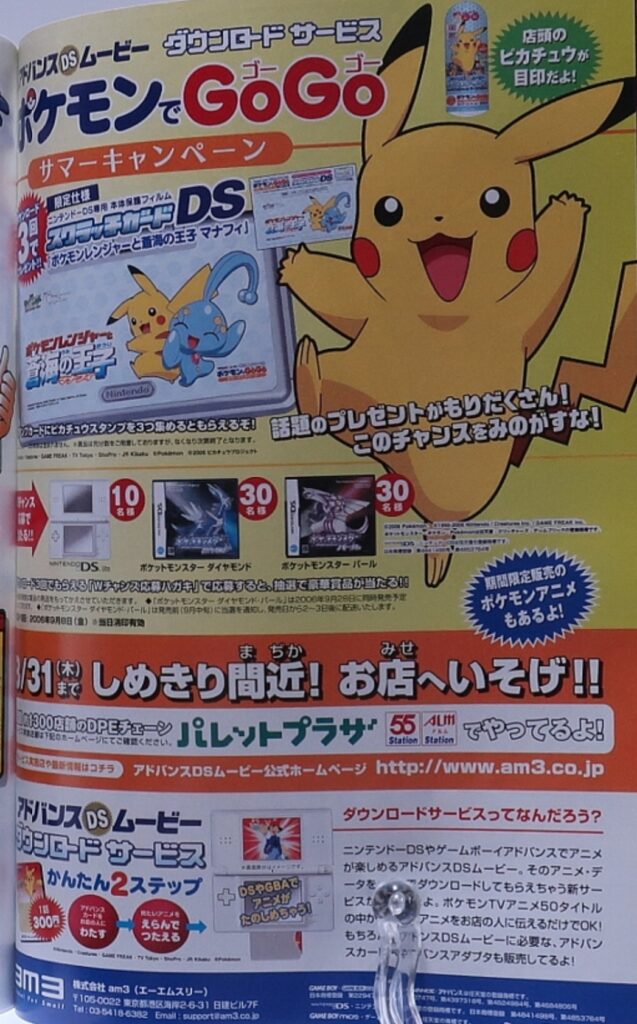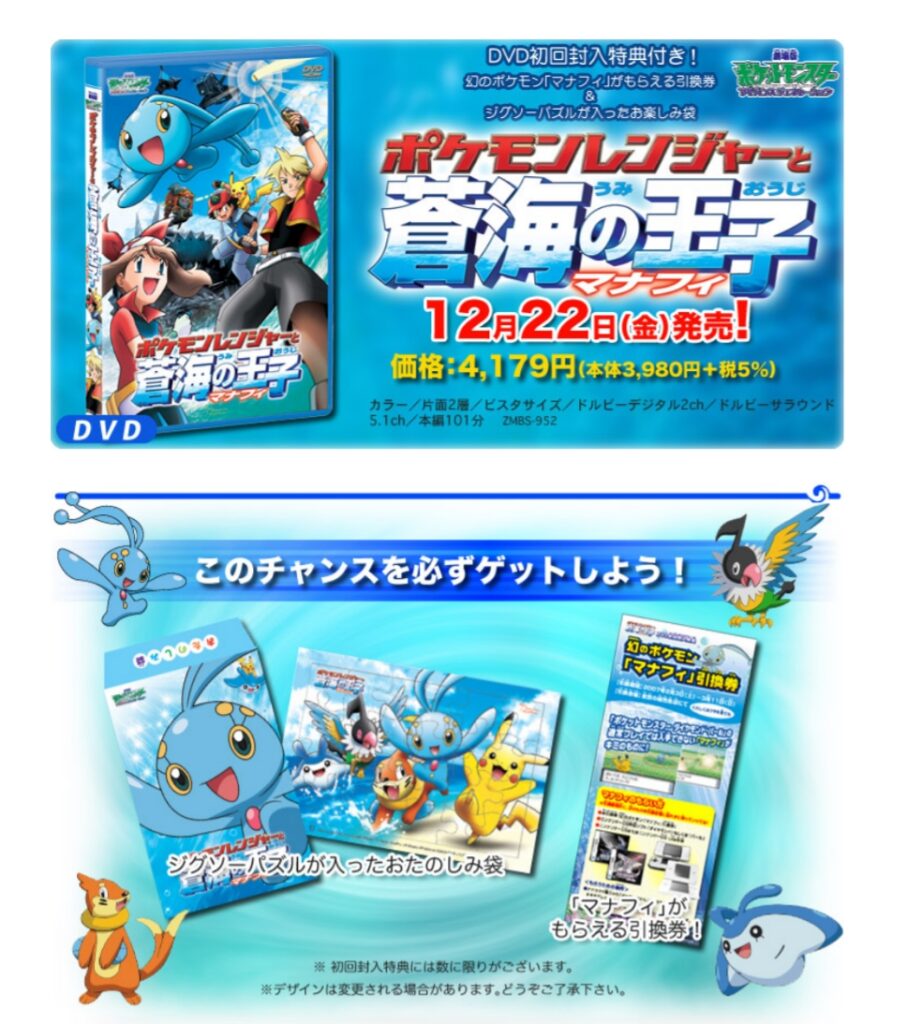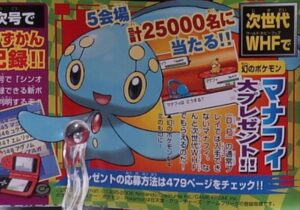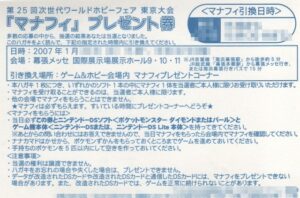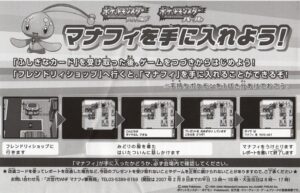“…I approached the Pokémon booth. On this year’s balloon, a giant Manaphy, and Uxie, Azelf and Mesprit were floating in the air. It was a strange combination and something I didn’t expect to see.”
Have you heard of the World Hobby Fair?1 In Japanese:「次世代ワールドホビーフェア」 Not to worry, I hadn’t either. It’s kind of a big deal. As Japan’s primary game and toy festival, World Hobby Fair (WHF) has been held twice annually, in Summer and mid-Winter, since 1994. During the cold months, this travelling circus hits a series of predetermined venues and convention centres across Japan in quick succession, starting with Tokyo’s immeasurably grand Makuhari Messe, followed by Osaka’s Kyocera Dome, Nagoya Dome, and Fukuoka Dome. Major manga companies such as Shogakukan (of Shonen Jump), toy companies like Banpresto (of Power Rangers fame), and game developers and publishers Nintendo, Sony, Bandai and Level-5 all routinely have exhibits there. TPC and GameFreak are ever-present, as well as omnipresent, to promote the Pokémon franchise.
Occasionally, event Pokémon will be up for grabs to visitors – just infrequently enough to be unexpected and a welcome surprise. Examples are the shiny WHF15 Rayquaza available for download at the Pokémon booth in 2015, or more recently, the WHF2020 “Max Raid Demo” Lapras & Coalossal that caught the world of Poké-collection off-guard. Quite frankly, these irregular occurrences do not usually attract a of lot of attention. Except, of course, that one time in early 2007, when in the most high-profile of the venue’s event distributions, the World Hobby Fair formed a designated stage – if not the stage – for the long-awaited, keenly anticipated Diamond & Pearl release of that timelessly popular Poké-mascot: Manaphy!
—
The years 2005-06 were an awkward transition period for the Pokémon franchise. The mainline video games central to the Pokémon universe were undergoing what I like to call “the long drought”. As GameFreak wrestled to program for the Nintendo DS and implement Diamond & Pearl’s planned touchscreen and global WiFi features, those next-gen games – originally scheduled for Fall 2005 – were pushed back a year to September 2006. Hastily another season arc was scripted for the Ruby & Sapphire anime. Summer 2005’s feature film, the first to feature a fourth generation Pokémon (Lucario), released on schedule and proved a smash hit, easing fans’ disappointment over Diamond & Pearl’s delay. The games Pokémon Mystery Dungeon, Link and XD – which cameod Bonsly and Munchlax, two fourth Gen Pokémon – helped fill in the void for late 2005. But that still left a full year sparse on content. Clearly something else was needed to bridge the gap to Diamond & Pearl prelease hype, keep devotees engaged, and avoid ceding the spotlight. But what?
The contours of TPC’s strategic solution were perceptible as early as mid-2005. With Diamond & Pearl delayed by a year, the chosen stopgap was to be Pokémon Ranger. A first information teaser appeared in the August 2005 issue of CoroCoro, hinting that this new “Ranger” (レンジャー) IP would comprise a movie and a video game. It was fair to assume that the two would be tightly (inter)linked; a notion that gained currency when in February 2006, CoroCoro teased a mysterious egg alongside a preview of that Summer’s movie, showing a tiny inset subtitled “This mysterious egg appears! (“そしてナゾタマゴ發見!”) Except… This was somewhat of a red herring. In reality, movie and game didn’t have much in common beyond the “Ranger” name.
Let’s start with the feature film. With an official title of “Pokémon Ranger and the Prince of the Sea”2 In Japanese: ポケモンレンジャーと蒼海の王子 マナフィ (Temple of the Sea in English), the movie was very clearly all about Manaphy.3 Official site: https://www.pokemon-movie.jp/history/history2006 In its third-Gen plot, Ash, May and friends come upon a Manaphy egg, which hatches in May’s arms while chased by a generic evildoer, and a 90-minute pursuit ensues culminating in (spoilers!) the dramatic restoration of Manaphy’s rightful home. Practically nothing is known about the creative process that fuelled Manaphy’s design. Yet it’s apparent that the huggable, free-spirited, puppy-eyed and slightly amorphous pale-blue blob resembles a clione, the adorable translucent sea creature that inhabits the cooler waters around Japan’s northern island of Hokkaido (which Gen 4’s Sinnoh region is based off) and has been prominent in the nation’s folklore and collective consciousness since time immemorial. When hard-pressed for a standard-bearing mascot in times of need, a clione Pokémon is a sure bet.
The Pokémon Ranger game, on the other hand, has bugger-all to do with Manaphy. Which is puzzling. This was not “a game based around next year’s movie”, as IGN had predicted. The movie’s plot is set around Hoenn’s Battle Frontier; the game, on the other hand, takes place in the remote region of Fiore and features a brand-new cast. With a release date of March 23, 2006, it’s likely that the Ranger game was (long) in development before the movie – or even Manaphy – were conceived, and that the story had already been tied down. It’s equally probable that the Ranger game was never meant to carry the full weight of the Pokémon franchise on its shoulders for a solid six months. As a mediocre title developed by affiliate studio HAL Laboratories (of the Kirby and Mother franchises), the game was burdened by highly repetitive, decidedly middling stylus-spinning gameplay geared towards younger audiences. Of course, that didn’t mean the Ranger game couldn’t be pressed into service to meet the needs of its time!
So, in an artfully convoluted, quintessentially GameFreak solution, the two were tied together in such a way to generate additional exposure (and sales!) for both. And in an absolute stroke of genius, this solution also bridged forward to Diamond & Pearl. The link, of course, was Manaphy.
…Or more precisely, Manaphy’s egg, and it’s here that we circle back around to Pokémon event history. In March 2006, it was announced that fans who pre-purchased their movie tickets between April 15 and July 14 would be rewarded with a downloadable, special “W Mission” that revolved around saving Manaphy’s egg from Fiore’s resident evil squad.4 In another part to the mission, Deoxys could be captured in a variety of forms. When I began writing this article, I was under the impression that moviegoers were instructed to bring their Nintendo DS with Pokémon Ranger inserted to pull in the W Mission via local wireless connection before, or after, watching the film. That would have been logical, right? But that’s not how it worked. Instead, players were instructed to present their voucher at participating stores between June 17 and August 31 2006.5 Dates derived from: http://park3.wakwak.com/~pokepale/get/b_1.htm
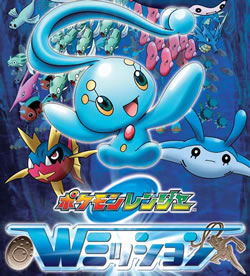 There a manual distribution method was used to give players their Manaphy. It’s known that The Pokémon Company (TPC) created a dedicated W Mission GBA distribution cart for the occasion (which also included the Deoxys mission). This cart was sent to participating stores, where staff would take a voucher-holders’ Nintendo DS with Pokémon Ranger in slot-1, insert the distribution cart into slot-2, and start a data transfer. In so doing, W Mission data was automatically stored in the savegame. It was a cumbersome method that one blogger rightly dubbed “very primitive”.6 Distribution method details courtesy of Purin, here: https://projectpokemon.org/home/forums/topic/6785-codes-for-pokemon-ranger-1-and-2; and Accyu’s blog: https://blog.goo.ne.jp/accyu0125/e/e35e4d805a57957f1dbf7a39b12b4479 When the Pokémon Ranger W Mission was finally made available in the United States came January 2007, and the EU June 2007, these international players had it much easier. The W Mission had been hardcoded into the game, and all one had to do to unlock it was input a universal serial code released via the Pokemon.com website.7Which is quaint in itself; in this day and age, the W Mission would have been datamined long before official release.
There a manual distribution method was used to give players their Manaphy. It’s known that The Pokémon Company (TPC) created a dedicated W Mission GBA distribution cart for the occasion (which also included the Deoxys mission). This cart was sent to participating stores, where staff would take a voucher-holders’ Nintendo DS with Pokémon Ranger in slot-1, insert the distribution cart into slot-2, and start a data transfer. In so doing, W Mission data was automatically stored in the savegame. It was a cumbersome method that one blogger rightly dubbed “very primitive”.6 Distribution method details courtesy of Purin, here: https://projectpokemon.org/home/forums/topic/6785-codes-for-pokemon-ranger-1-and-2; and Accyu’s blog: https://blog.goo.ne.jp/accyu0125/e/e35e4d805a57957f1dbf7a39b12b4479 When the Pokémon Ranger W Mission was finally made available in the United States came January 2007, and the EU June 2007, these international players had it much easier. The W Mission had been hardcoded into the game, and all one had to do to unlock it was input a universal serial code released via the Pokemon.com website.7Which is quaint in itself; in this day and age, the W Mission would have been datamined long before official release.
Even with the benefit of hindsight, the Japanese process was convoluted. News outlets like Dengeki Online put up lengthy articles dedicated to breaking down the procedure and stave off confusion among the wider public. CoroCoro Monthly’s June issue (released May 15) in particular explained step-by-step in beautiful visual detail the instructions for obtaining the Manaphy egg in Pokémon Ranger. There was just one catch: the egg itself couldn’t be hatched in Ranger. So why go through all this trouble?
As both the June and July 2006 issues of CoroCoro emphasized, the W Mission Manaphy egg would be transferrable to Diamond & Pearl upon the (delayed!) release of those games later in the year. Bloggers, too, stepped in to help explain transfer mechanics – take this GeoCities picture & text guide by pikachuftt, for example, whom we’ll meet again in the context of the World Hobby Fair. Because – who wouldn’t want to start the much-anticipated next-gen game with a cuddly, highly competitive legendary that takes your OT on hatching and thus obeys you from the very start? Anyone would! (So please buy the Ranger game! Only ¥4800. And see the movie! Only ¥1300!)
The million-dollar question – quite literally so, for TPC – is obviously: did this gap-bridging, Manaphy-centric marketing strategy work? It’s eminently impossible to say how many bought Ranger and saw the movie just to get their hands on an early Manaphy. We can conclude that Manaphy’s popularity spiked over the course of 2006/07. For instance, in early 2007’s “movie protagonist popularity poll”8 「歴代主役ポケモン人気No.1を決めろ!」 that gave rise to that Summer’s PalCity distribution, Manaphy finished second only to Deoxys and possibly the eighth movie pairing of Mew & Lucario (the results are equivocal), but beating fan favourites like Lugia, Celebi, Jirachi, and the Latis. It should be noted that nothing was left to coincidence in cultivating a Manaphy Mania. I’ve already mentioned how the February, June and July issues of CoroCoro put Manaphy front and centre. (The Pokémon franchise relationship with CoroCoro is famously intimate – Pokémon sells CoroCoro, and CoroCoro sells Pokémon.) In fact, all CoroCoros from February through September 2006 featured Manaphy in some capacity, advertising the movie, game, trading cards, and all manner of paraphernalia. There’s too much here to ignore, so let’s take a quick look.
The blue blob’s rapid rise to stardom well and truly kicked off with March 2006’s CoroCoro issue, lit up as it was by a giant two-page feature captioned “A New Pokémon Appears: Manaphy!”. It also dedicated a full page to the upcoming movie. The May issue upped the ante, as Manaphy occupied a solid 50% of the magazine cover. Again, the periodical advertised both the Ranger game and film. After June and July’s transfer mechanic issues, August 2006’s CoroCoro ran an ad for Japan Rail’s annual Stamp Rally, which that year put the spotlight on – you guessed it – Manaphy. That same issue offered “Prince of the Sea” movie ticket discount, a chance to win a limited edition Manaphy statuette, and peddled some Manaphy thingamajig from supermarket chain 7/11. Oh, and it showed off TCG’s first Manaphy card from the Movie Commemoration VS Pack. Finally, September 2006’s CoroCoro promoted a mail-in (?) prize contest for an unbelievably gorgeous, limited edition Pokémon GoGo “Summer Campaign”9 サマーキャンペーン DS Lite, Pikachu and Manaphy imprinted on its shell. (Only 10 were given away.) Not until October 2006, none months on, did CoroCoro see fit to print a Manaphy-free issue.
For most of 2006, Manaphy was omnipresent. If there existed skeptical voices about spending a princely sum (ha!) for a single Manaphy, the internet doesn’t much remember them. Enthusiasts like Accyu happily claimed theirs. Raw numbers certainly suggest that the carefully orchestrated Mania surrounding the blue blob worked contagiously. The movie did well enough at the box office, securing top anime (second overall) and maintained a solid chart position throughout its six-week theatrical run. The Ranger game, too, performed admirably, with 189.314 copies sold in the first week alone. This number climbed to an eventual 649.980 by late July 2007; we don’t have month-by-month sales data, but we can assume that the majority of copies got shifted in Q2 2006, ie. in time to secure a theatre W Mission egg. That’s a lot of potential Manaphy!10Ranger outsold Pokémon Link handily, but did not surpass the combined performance of GBA titles Red & Blue Rescue Team. Ranger’s first week was well and truly respectable; to lend some perspective, MarioKart DS only narrowly outperformed it (at 224.411 copies sold).11Incidentally, international copies of Pokémon Ranger continue to be sought-after today, as inputting the universal serial code is the quickest – and at most times only – independent way towards obtaining an authentic Manaphy. Japanese copies are in demand too, as by surmounting a few technical hurdles, W Mission data can be installed onto the cartridge from public repositories.
So, as Diamond & Pearl at long last hit the shelves, tens of thousands of players got to start their Sinnoh adventure with a cuddly, fresh-faced Lv.1 legendary. Good on them! But what of the holdouts, boat-missers, skeptics, and those who just didn’t care for the mediocre Ranger game? Were they marooned, destined to trawl the GTS hoping to snag a lucky stray Manaphy? Of course not! There was more mileage in Manaphy yet, and TPC knew it.
Enter the Prince of the Sea DVD release, which became available for purchase December 22, 2006. (Official announcement here.) Retailing for a healthy ¥4179 (~40US$), its “limited first edition” contained a few extra goodies, such as a Pokémon-themed jigsaw puzzle depicting Manaphy, Pikachu, and the movie’s minor co-stars of Mantyke, Chatot, and Buizel. And, mirroring the theatrical run’s early purchaser bonus, it also included a Manaphy voucher – not exchangeable for a Pokémon Ranger egg this time, but for an actual stylish event Manaphy, delivered directly to Diamond & Pearl at participating stores between February 3 and March 11, 2007. Like Ranger Manaphy and the Festa 2006 Electabuzz and Magmar that immediately preceded it, Pokémon transfer to players’ games happened exclusively via a staff-controlled slot-2 distribution cartridge. While WiFi technology was now available for this purpose and, incidentally, used to great effect to freely and (mostly) smoothly distribute the concurrent Shokotan Tropius to large numbers of hyped-up fans swarming PokeCenters throughout February, deploying it to spread Manaphy was not an option, as only DVD-buying voucher-holders were eligible to receive the Pokémon. The result was, all but inevitably, tremendous queues to come and collect, particularly on the distro’s first day: blogger “gamp” at PokeCenter Yokohama observed “a long line running hundreds of meters around the building” just to obtain Manaphy from a staffer.
The Trainer Name of this elusive creature was “mizu no tami” (みずのたみ; literally: “water people”), and its Trainer ID of 12226 reflected the DVD release date. This female OTN was a direct reference to the Prince of the Sea movie’s mystical water tribe. (Although, honestly speaking, OT “May” would have been more appealing than a perfunctory nod to a fairly anonymous group of water disciples – May is the one who hatched the movie’s Manaphy, after all!) The creature itself was Lv.5, held a King’s Rock and knew Tail Glow, Bubble, and Water Sport, which were the exact moves that any Ranger Egg-aphy also hatched with. Why-oh-why was it denied Manaphy’s signature move “Heart Swap?! This “water tribe” Manaphy also made for the blue clione’s first proper, non-egg next-gen distribution. Though I suppose, in a strictly technical sense, it was a buy-to-win repeat distro that, we can only assume, handsomely padded the transition period bottom line.
Because, you see, both CoroCoro and the Daisuki Club ran giveaway campaigns for this exact Manaphy. Or a pseudo-giveaway, in CoroCoro’s case, because one still had to purchase the December 2006 issue (released November 15) in order to participate! Naturally, the magazine featured Manaphy on the cover yet again; inside, half a page was set aside for detailing the “water tribe” Manaphy lottery. Presumably, an application slip was attached to the magazine spine. We’re clueless how many applications came through – if only we had median sales figures for all 2006/07 CoroCoro issues to poll oversale! What is certain, however, is that a total of 25.000 winners was chosen from among the applicants, likely at random, who received a “proof of victory” postcard in their physical mailbox in late December / early January.
The Daisuki Club’s giveaway for 10.000 total tribal Manaphy was entirely free-to-enter. Applications were open November 15 through December; winners received highly similar if not identical postcards to CoroCoro’s. (Official pokemon.co.jp page here.) Why the Club got to pick a mere 10.000 winners to CoroCoro’s 25.000 is not quite clear. Perhaps CoroCoro insisted on a bigger share of the Mana-pie to gain an edge over the free giveaway ran by a costless registration fanclub. Either way, TPC generously threw the Club’s largely junior Pokemon fans a bone. I’m sure they were delighted.
Came January 2007, some 35.000 Pokefans were now in possession of “Manaphy Present” victor postcards. What were they to do with them? Why, attend Winter 2006/07’s World Hobby Fair, of course! The postcards doubled as entry tickets and conferred the right to claim a Manaphy from WHF’s Pokémon booth! As always, the 2006/07 WHF set up shop in a number of cities, stopping by Osaka (Jan 14), Tokyo (Jan 20-21), Nagoya (Jan 28), and Fukuoka (Feb 4). Postcards were personal and non-transferrable. They also explicitly assigned the recipient a venue: 5000 CoroCoro Manaphy winners were allocated Osaka, another 5000 Nagoya, and so on. (Tokyo’s 10.000 were split across its two-day fair.) Similarly, 2000 Daisuki winners were expected to turn up at their assigned location only or risk being refused entry. Geography had been taken into account in matching players with venues; even so, fans sometimes travelled considerable distances, driving to Makuhari Messe “from the countryside” (this pokeblog) or making their way to Nagoya Dome (“quite far from my home”; torogamer). What commitment!
A handful of bloggers wrote about the giveaways, the special Manaphy itself, and their Hobby Fair experiences. Two of them, the aforementioned “torogamer” and “pikachuftt”, won their WHF tickets from the CoroCoro giveaway. Pikachuftt not only chronicled their Hobby Fair visit, but also thought to upload a high-resolution image of their Manaphy postcard and possessed the exceptional presence of mind to photograph the WHF’s Manaphy distribution cartridge. (More on that in a second; before I forget, here’s a major retroactive thank you!) Another two bloggers, the operator of a bany.bz pokeblog and one “tteiina”, struck it lucky in the Daisuki giveaway. Sadly, tteiina did not discuss his / her Hobby Fair visit (neglecting to even mention the city), and only flaunted the acquired Manaphy on their weblog (here). “Bany”, however, did, and it’s their textual account, plus torogamer’s and pikachu’s, that form the basis for much of what we know about the goings-on inside the confines of the 25th World Hobby Fair. Well, plus the thoughtful observations of a certain surprise visitor!12Trusty old 2channel regrettably isn’t much use here; Daisuki Thread #16 certainly touched upon the subject of WHF Manaphy, but did so mostly in the context of proclaiming victory and comparing venues. LINK
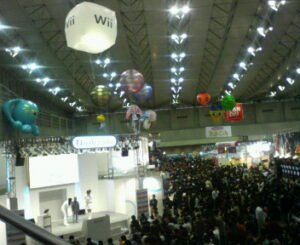
Tokyo Makuhari WHF. Manaphy balloon redemption point on the left, Lake Trio balloons (and Pokémon booths) in the center. Note the Wii stage. Image credit: bany.bz pokeblog
For starters, it’s apparent that the 2006/07 Hobby Fair racked up quite the visitor count. Not that this was terribly unusual – it does every year. When bany, pikachuftt and torogamer arrived at their respective venues (Tokyo and Nagoya), all discovered “tremendous queues”. Perhaps fearing a repeat of 2006 Festa’s inhumane waits for Magmar and Electabuzz, bany eyed the lines with trepidation. Were these people all Poké-enthusiasts seeking an elusive Manaphy? Once inside, they found the convention centres almost filled to capacity – torogamer considered the Nagoya Dome “overcrowded” and “difficult to navigate without losing your companion”. Looking at bany’s picture, taken from the Makuhari Messe’s top floor, it’s not hard to see why!
Various exhibition booths were “lined up in the center of the Dome”. The Manaphy redemption point, however, was somewhat off to the side, marked by a large Manaphy balloon suspended overhead that could be “seen at a glance” from the stadium’s spectator seats in Nagoya (Toro). Bany and Pikachuftt had no trouble spotting the Manaphy balloon, either, and made their way over through thick crowds. Bany gleefully obtained her Manaphy “without waiting at all”; when she entered the D&P Union Room to mix records with other Pokémon aficionados, she found it full of people (“awesome!”). Pikachuftt equally got her Manaphy “under the balloon”. (An anchor point is discernable in her pictures, with the staff trade table located roughly underneath.) It’s here that Pikachu went one step further, taking photographic proof that “water tribe” Manaphy too, like Ranger’s W Mission, was distributed the good-ol’ fashioned, time-tested way.
It should be noted that “Mystery Gift” itself saw some innovations going from Gen 3 to 4. No longer were event Pokémon to be traded into the player’s party by a staff member (e.g. Mystery Mew), spat out by a bulky cart-insertion machine (e.g. Japan’s GCEA), or transferred via a separate WiFi adapter, as been the case for most FRLG special Pokémon. Going forward, practically all events would be wondercard-based. Games could hold multiple of these wonder cards, not just a single one that had to be deleted on receiving additional Mystery Gift Pokémon (as had been the case with, for example, PC New York’s Wish Eggs). With a new mainstay distribution method came a new Pokémon pick-up method: the concept of the PokeMart collect-anytime “deliveryman” was pioneered early in Gen 4. Where players previously had to make space in their in-game party of six to directly and immediately accept an event Pokémon – incurring great delays for everyone in the queue if they forgot to prepare an empty slot – PokeMart NPC collection eliminated that problem. This greatly reduced hiccups during on-location distributions. (Quite handy, when 7000 transfers are scheduled daily!) As a whole, this revamped method was sufficiently revolutionary that TPC had an informational leaflet printed on behalf of players to explain the process (see inset).
For the earliest of Gen 4 distributions, GameFreak / TPC adopted a hybrid distribution setup with some vestigial elements. NDS hardware was perfectly capable of sending wondercards wirelessly to Diamond & Pearl games; D&P, in turn, had been programmed to support such a feature. But, perhaps to control the flow of Pokémon and distribute only to eligible players, this convenient hands-off approach to sharing Pokémon was seldom put to use in 2006/7. Many of the earliest Gen 4 event Pokémon such as Festa Magmar & Electabuzz (December 2006), 10th Movie Deoxys (July 2007), and of course water tribe Manaphy (January-March 2007) were circulated via slot-2 distribution cartridge, as captured so elegantly by Pikachuftt and, surprisingly, also by this mysterious mynavi.jp blogger.
Which immediately raises a few questions. Such as: how many Manaphy distribution cassettes were made? A minimum of nineteen, if the cart’s sticker from pikachu’s photograph is anything to go by.13Their labels read: “プレゼントキャンへーン専用カートリッジ” Assuming, however, that these very same cartridges were used to effect the nationwide DVD release Manaphy repeat distribution some weeks later, nineteen couldn’t have been nearly enough. Then again, I’ve not seen these cartridges make their way onto public marketplaces in recent years, so either TPC / GF monitored their whereabouts very closely, ensuring all were returned to headquarters after the event, or numbers were indeed rather few. Or both. (Pikachuftt sagaciously speculated at the time that, should any Manaphy distribution cartridge’s ever pop up on the open market, they’d command a high price!)14 “このカセットオークションで出たらすごい値段がつきそうですよね”
If anyone knew, or was able to learn the answer, it was Makuhari Messe’s incognito surprise visitor. For an hour on Saturday January 20, GameFreak Director Junichi Masuda explored the Hobby Fair.15Note that Masuda gave two “Adult Pokemon Course in 90 Minutes”-lectures in Shimonoseki on February 10-11, first at the “Open College”, then at Kaikyo Messe. Reportedly, he personally distributed water tribe Manaphy to attendees afterwards; it’s likely he used a distribution cassette for this. Sources are wiki-xn and pokepale. Struggling to navigate the “huge crowd” and find the Pokémon booths, Masuda spotted a “Pokémon balloon floating above” and followed it to arrive at his destination. To his delight, the Fair’s various Pokémon booths seemed “really popular”.16‘Hidden Power of Masuda’, Entry 70, January 22 2007, at: https://www.gamefreak.co.jp/blog/dir_english/2007/01/index.html; opening quote ibid. By this time, Pokémon Diamond & Pearl had been out several months and, from day one, sold like hotcakes, setting Nintendo DS sales records in the process. The Pokémon franchise, then, had weathered the transition period. And it was, in no small part, thanks to that azure mascot hovering overhead: Manaphy.
—
Say you were a Japanese player who saw the “Ocean Prince” theatrical release but didn’t own a copy of Pokémon Ranger, owned Ranger but somehow had no opportunity to buy a movie ticket, didn’t care to spend ~¥4000 on a DVD, won neither the Daisuki Club nor CoroCoro giveway, and were moreover absolutely friendless, and therefore still had no Manaphy on your Diamond & Pearl game by mid-2007? Well! You could bide your time until 2008 and buy yourself a full-retail priced egg with Shadows of Almia, the sequel to Pokémon Ranger. Or, if you had the good fortune to hail from the Tokyo Metropolitan Area, salvation might come a little sooner, provided you stopped by Summer 2007’s festivities known to us as PalCity. Read here!
- Harvest Moon 3 (2001) - March 5, 2020
- Pokémon Trading Card Game 2 (2001) - February 5, 2020
- Yu-Gi-Oh! Dark Duel Stories (2002) - January 5, 2020

